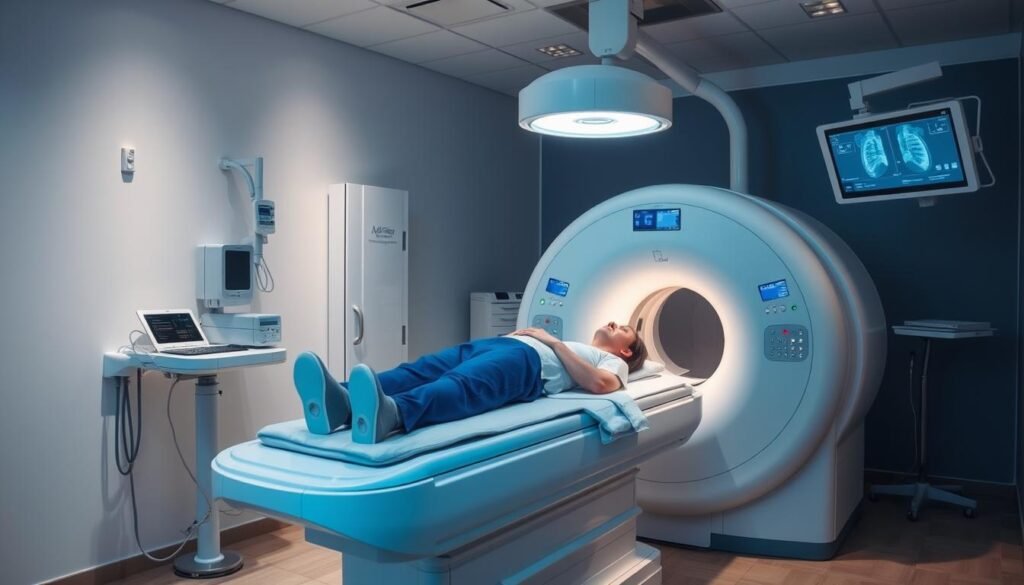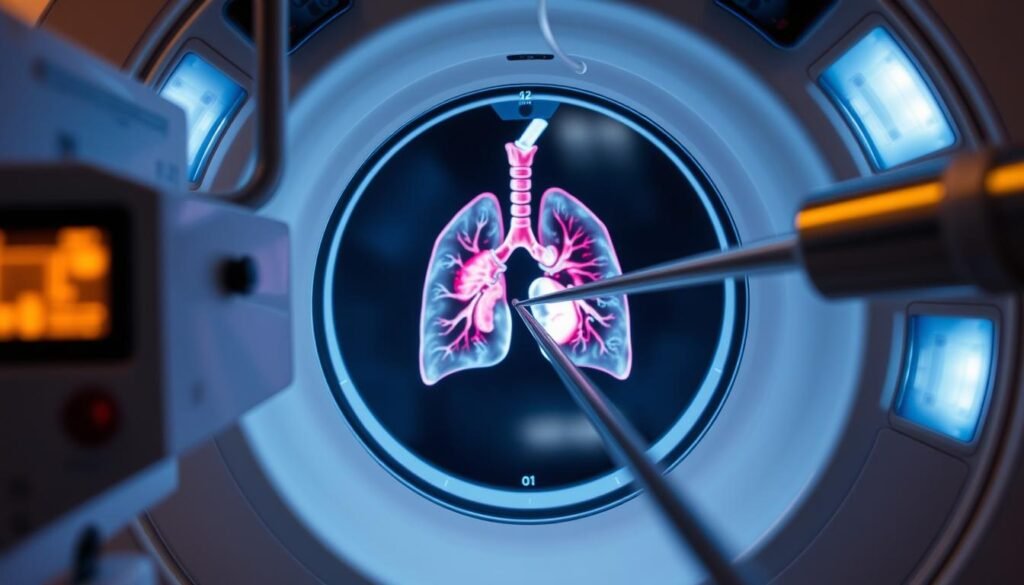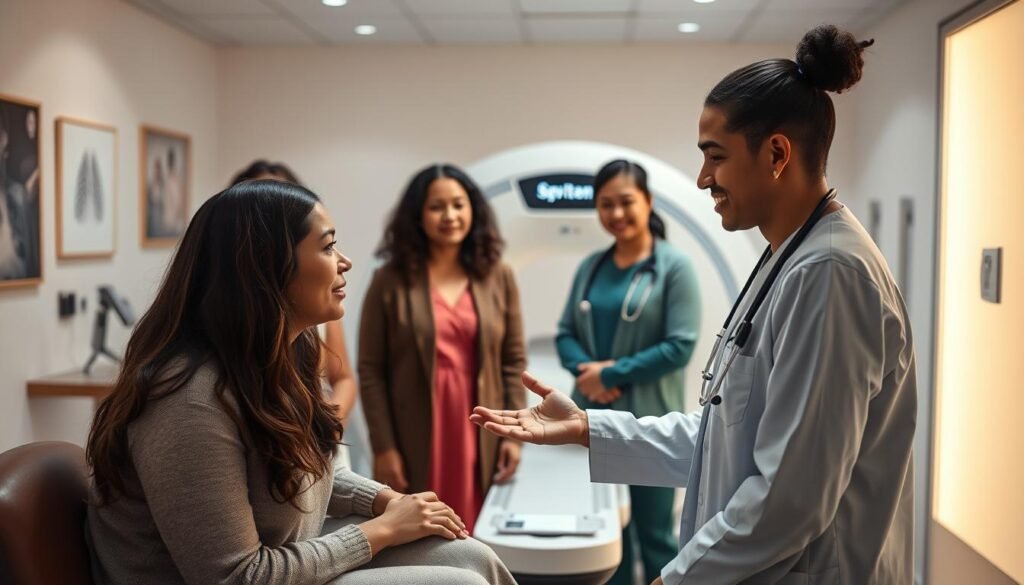Lung cancer is the top cause of cancer deaths worldwide. It causes nearly 1.8 million deaths each year. Early detection and effective screening are crucial for fighting lung cancer. Knowing how doctors screen is critical for people at high risk. This includes smokers or those who have smoked a lot in the past.
The US Preventive Services Task Force advises certain people to get checked yearly. They recommend it for those aged 50 to 80 who have smoked a lot over the years. A low-dose CT scan can catch lung cancer early. This greatly increases the chances of successful treatment. That’s because lung cancer often doesn’t show symptoms until it’s advanced.
Doctors use a mix of methods to diagnose lung cancer. These include reviewing medical history, physical exams, and advanced imaging techniques. If you’re thinking about lung cancer screening, talk to a doctor. It’s important to understand the benefits and risks. These methods can sometimes give false positives or find cancer that’s not a threat. But early detection of lung cancer can save lives. The survival rates are much better when the disease is caught early. For more details on lung cancer screening, visit lung cancer screening guidelines.
Key Takeaways
- Lung cancer is the primary cause of cancer-related deaths across the globe.
- Annual low-dose CT scans are essential for early detection, especially for high-risk individuals.
- Many patients may not show symptoms until lung cancer has reached advanced stages.
- Screening decisions should be made in consultation with healthcare providers to assess risks accurately.
- Understanding how lung cancer is diagnosed can lead to earlier intervention and improved survival rates.
- Current screening guidelines prioritize proactive measures for individuals with a significant smoking history.
Understanding Lung Cancer and Its Impact
Lung cancer is the second most common cancer in the United States. The impact of lung cancer is huge, being the top cause of cancer deaths. Heavy smokers are at a significantly increased risk, as shown in recent statistics.
Many don’t know that lung cancer doesn’t show symptoms early on. This makes finding it early key to successful treatment. When symptoms do show, the cancer might already be in advanced stages. This highlights why regular screening is vital for those at risk.
Diagnosing lung cancer involves several imaging tests. CT scans, MRI scans, and PET scans play a key role in spotting cancerous growths. These scans help doctors get a full view of the tumor and if it has spread.
Learning about lung cancer facts can encourage people to get screened and take preventive steps. Knowing your risk factors and talking regularly with your doctor can lead to early action. This can greatly improve outcomes for those affected by lung cancer.
Importance of Early Detection of Lung Cancer
Lung cancer is the second most common cancer in the United States. It’s the top cause of cancer-related deaths. Detecting it early can greatly improve treatment success. However, many don’t show symptoms until it’s too late. Knowing early symptoms is key.
Screening with low-dose CT scans is a proactive step. These scans help find cancer early, even without symptoms. It’s crucial for people 50 to 80 who smoked a lot in their past. Early detection could stop the cancer from getting worse.
Screening has its downsides though. It uses a bit of radiation, and it might not catch every cancer. Even with screening, only 21% of lung cancers are found early. It’s vital to keep up with health checks. Talking to a doctor about your health and screenings is important.
Lung Cancer Screening Guidelines
The American Cancer Society and the US Preventive Services Task Force set guidelines for lung cancer screening. They recommend yearly screenings with low-dose CT scans for adults 50 to 80 years old with a heavy smoking history. This means if someone has smoked one pack a day for 20 years, they qualify.
It’s very important to assess lung cancer risk, especially if someone smokes or quit in the past 15 years. Talking with a doctor about lung cancer screening guidelines is crucial. This conversation helps people make wise health decisions. Screening is for those healthy enough for potential treatments.
While low-dose CT scans help catch cancer early, there are risks. Issues like false positives, overdiagnosis, and exposure to radiation can happen. That’s why it’s important for patients and doctors to decide together on screening. The advice is to stop screening at 81, after 15 smoke-free years, or if serious health issues arise.
Insurance often covers the cost of these screening tests, but extra follow-ups might cost more. Knowing the different lung cancer screening rules, like those from the American College of Radiology, helps avoid mistakes and false alarms.
How Do Doctors Check for Lung Cancer
Doctors start checking for lung cancer by looking at medical history. They need to know your smoking habits and if you’ve been around things that could cause cancer. They also ask if your family has had lung cancer. This helps doctors figure out your risk.
Medical History and Physical Examination
A physical exam also helps find lung cancer. The doctor listens to your lungs and looks for signs like weight loss or finger changes. They check for symptoms like:
- Persistent cough
- Chest pain
- Shortness of breath
- Wheezing
If the doctor thinks you might have lung cancer, they will do more tests to be sure.
Identifying Symptoms of Lung Cancer
Finding symptoms early is key to catching lung cancer. Some people notice their cough changes or they’re very tired and lose weight without trying. If these symptoms come up, doctors might do special tests. This way, they can catch lung cancer early and start treating it.
Imaging Tests for Lung Cancer Diagnosis
Early lung cancer diagnosis relies on different imaging tests. Each test is designed to find important disease traits. These methods help doctors see lung issues early, leading to quicker treatment.
Chest X-Ray for Lung Cancer
The first test usually done is a chest x-ray. It gives a wide view of the lungs to spot large tumors. But, it’s not perfect. Small lung cancers might not show up, especially early on. This means more tests are often needed for a correct diagnosis.
CT Scan for Lung Cancer
The CT scan is highly regarded for its detailed images. It’s great at finding smaller tumors and tracking the disease. The low-dose CT scan also reduces radiation but keeps image quality. This balance is key for regular checks.
Other Imaging Techniques
There are more tools besides x-rays and CT scans. PET scans check if lung spots are cancerous and look for cancer spread. MRI scans, though not common for lungs, help find cancer in the brain or spine. Hospitals are now using PET-CT scans more. They blend regular images with functional data. This gives a full view for diagnosing lung cancer.
Low-Dose CT Scan Screening
Low-dose CT scan screenings are key for spotting lung cancer, especially in long-time smokers. It’s better at finding early-stage lung cancers than old chest X-rays. This makes it a big deal in the fight against lung cancer.
Doctors often say older adults who smoked a lot should get yearly low-dose CT scans. If you’ve smoked for 20 years or quit in the last 15 years, you should think about these tests. The NELSON trial results showed a big drop in lung cancer deaths thanks to these scans. There was a 33% decrease in deaths for women and a 24% dip for men who got scanned.

The scan is quick, taking less than a minute, and you’re at the doctor’s for around 30 minutes. You’re exposed to about 1.4 millisieverts (mSv) of radiation. That’s way less than a regular CT scan gives. For reference, we all get 3 to 5 mSv radiation yearly from our surroundings.
Even though low-dose CT scans are helpful, they’re not perfect. They do have downsides like a bit of radiation and the worry over seeing something unusual. Also, there’s a chance of false alarms that could lead to more tests. But catching lung cancer early can save lives, so these scans are important for those at risk.
Diagnostic Tests Besides Imaging
Tests for lung cancer go beyond just looking at images. They include getting tissue samples to confirm if someone has lung cancer. To find out the type and extent of lung cancer, doctors use different methods. These include various ways to take biopsy samples and checking mucus (sputum cytology).
Biopsy for Lung Cancer
A biopsy is key in diagnosing lung cancer because it examines tissue samples. There are many ways to do a biopsy. Needle biopsies take cells from the lung with a thin needle. Another method, thoracentesis, collects fluid from around the lung to look for cancer. Which biopsy method is used often depends on where and how big the suspected tumor is.
Sputum Cytology for Lung Cancer
For sputum cytology, doctors examine mucus to find cancer cells. This is useful for patients who cough up mucus often. Sputum cytology works best in finding cancer that’s more advanced. Knowing early lung cancer symptoms is important. They can signal the need for these tests.
| Diagnostic Method | Description | Advantages | Limitations |
|---|---|---|---|
| Biopsy | Tissue sample extraction from the lung. | High accuracy in confirming cancer type. | Invasive procedures may pose risks. |
| Sputum Cytology | Analysis of mucus for cancer cells. | Non-invasive and simple to perform. | Lower sensitivity in early-stage cancer. |
Learning about these tests helps in catching lung cancer early and planning treatment. For details on early lung cancer signs, visit this resource.
CT-Guided Needle Biopsy: A Closer Look
The CT-guided needle biopsy is key to diagnosing lung cancer. It provides precise sampling of lung lesions. This process is usually done in 30 to 45 minutes, quicker than surgery.

Patients get a local anesthetic to reduce discomfort. They have their vital signs checked. Then, they are informed about the process and give permission for it. The procedure requires patients to stay still as a needle is inserted to collect samples.
However, this biopsy method has some risks. These include:
- Bleeding
- Chest infection
- Temporary need for extra oxygen
- Rarely, a collapsed lung (pneumothorax)
Typically, results are shared within 1 to 2 weeks. Patients might stay overnight for safety. They can get back to daily life in a few days. Following aftercare advice is important to catch any issues early.
The CT-guided needle biopsy is less invasive than other lung cancer biopsy techniques. It is a top choice for tissue samples. The pathologist checks these samples to understand the lung issue. This method offers less pain and quick results. It’s vital for winning against lung cancer.
| Aspect | Details |
|---|---|
| Duration | 30 to 45 minutes |
| Anesthesia | Local anesthetic |
| Risks | Bleeding, infection, pneumothorax (rare) |
| Result Wait Time | 1 to 2 weeks |
| Hospital Stay | Overnight (if needed) |
Emerging Technologies in Lung Cancer Detection
The battle against lung cancer is changing thanks to new detection technologies. Older methods have limits that new ones are overcoming. Now, liquid biopsies are leading the way. They find early lung cancer signs by checking blood for tumor DNA. This is great for spotting cancer early and watching how treatments work.
Exciting research shows big wins. The National Lung Screening Trial (NLST) found a 20% drop in deaths from lung cancer with early checks. But, stage I detection is still low, at only about 20%. There’s a huge need for better screening tools. Cutting-edge tech, like AI, is stepping up to meet this need.
AI can spot lung cancer risks without needing images. One system got a 0.90 score for finding high-risk patients. Another, called Sybil, figured out a six-year risk from just one scan. And LUMAS beat even expert doctors. It got a 0.94 score for predicting risks in a year.
AI is changing how doctors find and treat lung cancer. Bossmann’s blood test can find 90% of lung cancers. It’s cheaper and easier than a CT scan. This test works by measuring certain enzymes. It’s backed by tech that uses 18 tiny sensors for fast results.
Research is also looking at tests for other cancers, like ovarian and breast cancer. This new wave of tech could lower death rates from lung cancer. It’s a big step forward in fighting this tough disease.
Benefits and Risks of Lung Cancer Screening
Lung cancer screening is key in finding the disease early. The lung cancer screening benefits allow for detecting most lung cancer cases at a treatable stage. Studies show annual low-dose CT scans (LDCT) significantly lower lung cancer deaths.
However, the risks of lung cancer detection need careful consideration. About 12-14% of initial screenings give false positives. This leads to unnecessary worry and invasive tests that may not help the patient. Even though newer screening tools are improving, challenges still exist.
Talking with healthcare providers is vital. Doctors must explain the early screening pros and cons well. They should share that only one out of every 320 high-risk people screened will avoid lung cancer death over five years.
Adding to the concern, 95% of abnormal results from scans are false positives. This shows the real risks of lung cancer screening. The National Lung Screening Trial showed a reduction in risk. But, updates suggest the benefit might not be as big as first thought.
It’s important for people to make informed choices about lung cancer screening. Quitting smoking and knowing early symptoms are key. In-depth talks with doctors can help decide the right steps. For more on early signs, visit this resource.

Conclusion
The path to understanding lung cancer is vital, especially the role of catching it early. Lung cancer is the top cause of cancer deaths. Sadly, only about 15.6% survive past five years. This fact shows why we must screen for lung cancer and teach people about it. Scientists now use a special scan called spiral low-dose computed tomography (LDCT). It can spot the disease sooner, which could save more lives and cut down deaths.
To make a big difference, we must identify those at high risk. This includes people between 55 and 80 who have smoked a lot. Spotting lung cancer early can radically change how well treatments work for them.
There’s also a big problem with how lung cancer affects different groups unequally. This needs our quick action. A detailed report on lung cancer screening shows that regular checks can save many lives. If people know about screening options and see their doctors often, they can better manage lung cancer risks. Taking these steps early can greatly improve one’s life quality and length.
Finally, we must stress the value of early lung cancer detection. Everyone should use the resources available to talk to their doctors about lung cancer risks and treatments. Being informed and proactive can significantly lower the death rates from this terrible disease. It can also offer hope to those facing lung cancer.